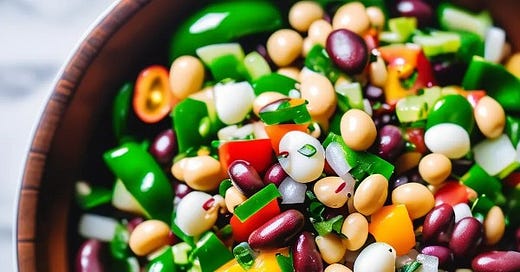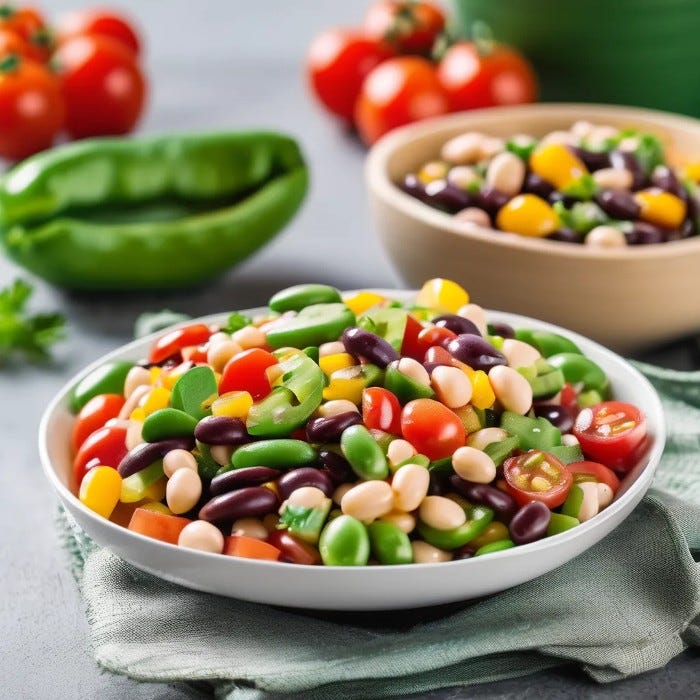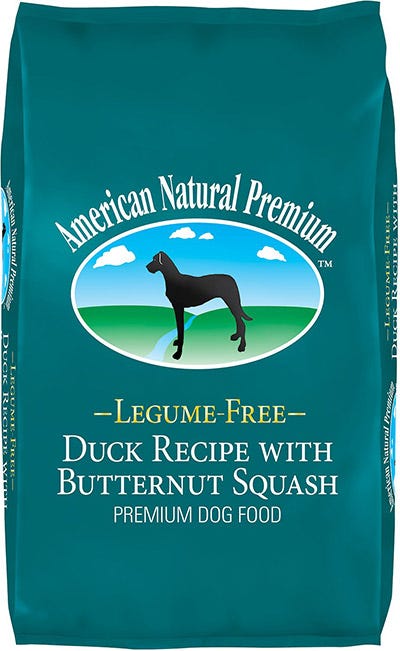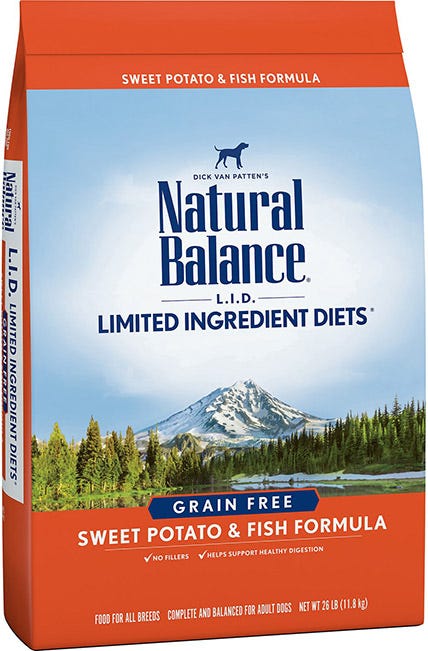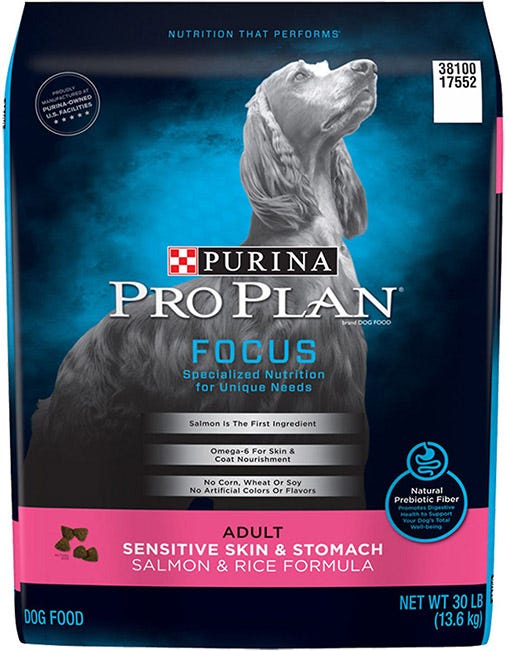13 of the best legume-free dog food
ADVERTISEMENT: The pet shopping trip you didn't know you needed to take
Writer’s note: The following listicle was originally published on July 1, 2020 at the now-defunct website Dog Struggles. There were originally 15 options, two of which are no longer available. The listicle has been lightly edited for technical details and readability. (If you’re interested in reading non-pet-related top 10-, 15- and 20 lists, click here.)
As an Amazon Associate, and if you use my referral links, I earn a percentage from qualifying purchases of the recommended items below.
Beans, beans, they’re not a fruit. Yes, we know the rest of the short little rhyme. But for your pup, this is no joking matter. For some dogs, legumes can cause serious stomach and digestive issues.
So what are legumes? Common examples you’ve heard of include alfalfa, beans, carob, chickpeas, clover, lentils, lupins, mesquite, peanuts, peas, soybeans and tamarind.
Scroll to the bottom of this post for answers to legume-free FAQs:
Are peas, potatoes, legumes and lentils bad for dogs?
Is this the right diet for my dog?
How do I handle picky eaters?
Whether you’re looking for the best legume-free dog food or just a meal that will keep him from needing multiple walks in a short time, stay away from beans (adzuki, cannellini, Great Northern, kidney, lima, navy, pinto and soy beans); black-eyed peas; chickpeas; lentils (green and split red); and peanuts.
While it may seem odd that these options are in dog food, you’d be surprised how much byproduct meal (that may not even look like it’s there) sneaks its way in as a filler. Let’s explore 13 options of dog food without legumes.
1. American Natural Premium
This dry dog food option is completely free from chicken, corn, legumes, potatoes, wheat and soy to assist pups with sensitive stomachs.
Key Features
4 lbs
Real duck recipe
Butternut squash
Crafted with menhaden fish oil, which is naturally packed in omega-3 fatty acids, this food combination is 100% free from artificial colors, flavors or preservatives. The prebiotics and probiotics in this pea-free food should also be helpful for your dog’s immune health and promote healthy skin and a lustrous coat.
Cons
Not suitable for dogs with sensitivities to grain (has ground grain sorghum)
In options like these potato-free dog foods, the food variety contains 25% of crude protein content (minimum). Of that, 75.12% is derived from animal sources, and the ash content is 7.28%.
2. Royal Canin
If you’re looking for dog food without peas, this hydrolyzed protein dry option may be what your dog needs.
Key Features
7.7 pounds
Requires veterinary approval
Special blend of fibers and prebiotics
This dry food is designed for dogs with food sensitivities. The veterinary-exclusive formula can reduce skin and GI reactions caused by common proteins that are found in dog foods. Proteins are made smaller to avoid immune concerns.
Cons
Dog owner (on Chewy) reported pup had “terrible diarrhea”
A few users complained of a bad “chemical” smell
The essential nutrients in this limited ingredient dog diet, which support skin health and reinforce the dog’s skin barrier, is best for dog owners looking for fiber blends that improve their pups’ healthy digestion.
3. Natural Balance
This complete, balanced food for adult dogs is suitable for all breeds, and without all the usual fillers.
Key Features
Real salmon
Sweet potato
Canola oil
With a perfect balance of omega 3 and omega 6 fatty acids, this grain-free dry food is intended to make your pup’s coat healthy and shiny. It also eliminates corn, wheat, soy and peas. There are no artificial flavors or colors.
Cons
May cause alarmingly foul feces smell, according to a Chewy reviewer
Suitable for dogs with food allergies and sensitive stomachs, this easily digestible meal provides premium carbohydrates and potassium.
4. True Acre
This grain-free food without potato and peas helps strengthen muscles, and supports a lustrous skin and coat.
Key Features
U.S. farm-raised chicken (first ingredient)
Omega 3 and 6 fatty acids (canola oil, flaxseed oil, fish oil)
Available in two sizes (30 pounds, 40 pounds)
Finding grain- and potato-free food doesn’t have to be hard to do, and True Acre caters to dog owners who want their pups to have a completely balanced and nutritious meal. Without wheat or corn, this dry dog food package includes antioxidant vitamins A and E. It also has field-harvested peas, carrots and cranberries. The natural fiber food is good for digestion and supports lean muscle mass.
Cons
Not available in small bites form
Poultry byproduct and soybean meat are included with real meat
The meat protein is sourced in the U.S. Vegetables are sourced from trusted farms in the U.S. or Canada, and all other ingredients are sourced from reputable suppliers in the U.S. and worldwide. All suppliers reportedly follow robust quality standards and FDA regulations.
5. American Journey
In this limited-ingredient food without peas, beef is the first ingredient.
Key Features
Available in two sizes (14 pounds, 28 pounds)
Deboned beef
Chicken meal and chicken fat
Intended to support a healthy immune system, this dry food is fortified with antioxidants. Powerful nutrients in the combination provide natural fiber for good digestion, omega fatty acids for a healthy coat and skin, antioxidants for a healthy immune system, and DHA to support brain and vision development. This meal also includes wholesome grains, and premium fruits and vegetables (i.e. carrots, blueberries and cranberries).
Cons
Contains barley and rice, so it may not be best for some dogs who need a grain-free diet
Several Chewy reviewers reported that their dog refuses to eat the food
This protein-filled meal is full of meats, healthy grains (i.e. natural fiber) and wholesome fruits and vegetables to add more energy to your dog’s daily dietary needs. It also has no poultry byproduct meal corn, wheat or soy.
6. American Natural Premium
This dog food combination is a triple protein recipe with ancestral grains, including duck with butternut squash.
Key Features
4 pounds
Duck recipe
Butternut squash
This premium dog food, with no GMO ancestral grains, is enhanced with prebiotics and probiotics to support healthy immunity. Omega-3 fatty acids from menhaden fish oil encourages healthy skin and a shiny coat.
Cons
One Chewy reviewer said the dog wouldn’t eat the food
Kebbles may be considered too big for small dogs
Intended to support your dog’s immune health, this omega-3 fatty acid option is also 100% free from artificial colors, flavors or preservatives.
7. Taste of the Wild
This grain-free recipe is highly digestible recipe and made with proprietary K9 strain probiotic blend.
Key Features
Grain-free Roasted bison and roasted venison
Optimal amino acid
Antioxidants
This combination of dry dog food includes sweet potatoes, peas, tomatoes, blueberries, raspberries and dried chicory root. While bison and venison are the primary ingredients, this family-owned brand is intended to create a healthy digestive and immune system.
Cons
Made in a facility for dog food with grains; may be present in meal
Several dog reviews reported vomiting after eating this dog food combination
Highly digestive meals like this are important for the following reason. Approximately 70% of a dog’s pet’s immune system is found in the gut, which means it makes sense to choose a food that’s good for the digestive tract.
8. Ziwi Pea
This free-range recipe is air-dried, made from free-range farming and without the kind of artificial fillers that may be common in other brands. This hormone-free food is suitable for all dog breeds at any stage.
Key Features
Available in three sizes (1.8 pound, 3.3 pounds, 7.1 pounds)
Available with six meat options (beef, chicken, lamb)
100% ethically sourced from New Zealand
This meal has no rice, grains, soy or potatoes. Heart-healthy and available to be used as a meal topper for a more traditional meal, this recipe is made from 96% fresh meat, organs and bones, in addition to green mussels, organic kelp and green tripe. There are no peas, legumes, added sugars, grains, glycerins or potatoes included.
Cons
Several users reported food sitting in storage too long and being too hard to chew or having a white film
One Chewy reviewer was concerned about a dog’s stool looking exactly like the food instead of breaking down
Considering three portions of raw ingredients make up one portion of finished air-dried food, your dog will need to be fed less and have less poop breaks (or less volume on the walk).
9. Purina Pro Plan Focus
Intended for dogs with sensitive skin and stomach problems, your dog may enjoy this salmon, oatmeal and rice dry dog food combination.
Key Features
Available in two sizes (16 pounds, 24 pounds)
Salmon (number one ingredient)
Sunflower and fish oil
In addition to salmon and rice, this omega-6 and omega-3 fatty acid combination supports healthy joints, mobility and coat. With its natural prebiotic fiber, this food option supports immune system health.
Cons
Some dogs will not eat it
One Chewy owner said the dog started panting after eating the meal and became restless and burped
There is no corn, wheat, soy, artificial colors or flavors, poultry or byproduct meal.
10. Rachael Ray Nutrish
This natural dry food has added vitamins and minerals, in addition to the healthy meal of chicken and veggies.
Key Features
S. farm-raised chicken (first ingredient)
Brown rice
Available in four sizes (5.5 pounds, 6 pounds, 13 pounds, 14 pounds, 40 pounds)
This dry food has no poultry byproduct meal, fillers, wheat or wheat gluten ingredients. It also includes beet pulp, peas and chicken fat. Wholesome grains in this meal have all the fiber needed for healthy digestion and overall well-being. Prepared in American facilities, this food is suitable for small, medium and large breeds. It has natural prebiotics for healthy digestion, and has no artificial flavors or artificial preservatives.
Cons
One dog owner said her dog, who has never turned down a meal in seven years, won’t eat it
Corgi and Border Collie dog’s hair fell out, according to one user, and may be at risk of endocrine dysfunction
This dry food option does not contain dyes, and uses mixed tocopherols as a natural alternative to synthetic preservatives.
11. Diamond Naturals Grain-Free
This natural food option is grain-free and a healthy diet for all stages of life.
Key Features
Available in three sizes (5 pounds, 14 pounds, 28 pounds)
Whitefish (number one ingredient)
Sweet potato
These superfoods have a high-nutritional value to support your furry friend’s development and overall health. In addition to fish and potatoes, this high-fiber dry dog food mix includes kale, blueberries and raspberries. Along with omega fatty acids to help promote healthy skin and a shiny coat, the whole foods come in handy for lea n nutrition and to help support strong muscles. It also has no corn, wheat, filler, artificial flavors, colors or preservatives.
Cons
One owner’s (usually) wet stool became dry and hard
One owner’s Golden Retriever loved it but the Border Collie did not, so some dogs may be pickier than others
Made in the United States and family-owned, this meal is backed by scientifically advanced food safety protocols. The proprietary probiotics support digestion.
12. Wellness CORE
Enjoy whole body health from this high-protein food option with the help of omega fatty acids, antioxidants, glucosamine, hydrochloride and probiotics.
Key Features
Deboned turkey and turkey meal
Chicken meal recipe
Available in three sizes (4 pounds, 12 pounds, 22 pounds, 26 pounds)
This grain-free meal has no meat byproducts, fillers, artificial preservatives or flavors. Improve your dog’s healthy coat with omega fatty acids (flaxseed and salmon oil). This protein-rich, nutrient-dense and grain-free meal has multiple health benefits: optimum fat and calorie levels, and fish and flax omega blend for healthy skin and coat. The coated kibble has probiotics to support the dog’s digestive health, which are infused with superfoods (spinach, broccoli, kale).
Pros
Leaner body mass and muscle tone
Supports a healthy coat
Cons
Several dogs won’t eat the food
One reviewer reported a Lab with acid reflux from eating this
Made with antioxidants, omega fatty acids, glucosamine and probiotics, this nutrient-dense food is an ideally balanced diet for adult dogs.
13. Wag
Amazon has decided to dive into its own private label dog food market. Made in California, a U.S.-based family-owned facility brings this high-quality meal.
Key Features
Available in two sizes (5 pounds, 30 pounds)
Available in four meaty options: beef, chicken, lamb, salmon
Omega 3 fatty acids (salmon oil and flaxseed)
Nutritious vegetables in this dry dog food include lentils and peas, which provide vitamins, minerals, antioxidants and phytonutrients. This dry dog food contains no added grains, corn or wheat. Made with an optimal blend of nutrients and fat, each serving contains 35% of protein. There are no added artificial colors, flavors or chemical preservatives that is formulated with veterinarians’ help.
Cons
Unclear who the manufacturer is; just listed under an Amazon address
One reviewer reported loose poop and bad gas
Trace presence of substances not included in the ingredient deck may be present.
Key Information about Legumes-Free Dog Diets
Are peas, potatoes, legumes and lentils bad for dogs?
Between January 1, 2014 and April 30, 2019, the Federal Drug Administration received 524 reports of canine dilated cardiomyopathy (DCM), which consisted of 515 dogs and nine cats. According to the American Kennel Club, most of the reports were submitted after the FDA’s first public alert in July 2018.
The total number of pets affected is almost certainly more than 524 because the reports came from multi-pet households. Certain grain-free dog foods were particularly of interest, such as dog food containing legumes, peas, lentils, legume seeds and potatoes, as primary ingredients.
So what exactly is DCM? It’s a type of canine heart disease that affects the heart muscle. Dogs with DCM may be at risk of heart problems that result in a decreased ability to pump blood. In the worst-case scenarios, this can result in congestive heart failure.
Larger breed dogs are already at higher risk of DCM, mainly Doberman Pinschers, Great Danes, Irish Wolfhounds, Newfoundlands and Saint Bernards.
Looking into grain-free foods (meaning ones with no corn, soy, wheat, rice, barley or other grains) — or foods that contained beans, chickpeas, lentils, peas or potatoes (including sweet potatoes) — there appeared to be a higher risk of DCM related to them.
AKC confirms that 90% of foods reported in DCM cases were grain-free. For dog food containing peas and/or lentils, that number increased to 93%. The number significantly dropped to 42% for dog food with potatoes and/or sweet potatoes. While raw, semi-wet and wet dog food were involved in some cases, dry dog food took the brunt of the blame.
The problem with banning these foods from your dog’s dietary needs is it may not always be the food. It could be other ingredients commonly found in dog food such as exotic meats, vegetables, and fruits as substitutes for grains.
But as with any dog food, and with varying breeds, some dogs may have an issue with it while others won’t. When trying out new dog foods, pay close attention to any physical or mental changes in your dog’s behavior. If anything alarming happens, seek veterinary help immediately.

Is this the right diet for my dog?
As with any healthy dog option, there will be some dogs who will have an adverse effect to eating these meals. Some may have absolutely no problem with grains, peas, carrots, legumes, potatoes, brown rice and other ingredients found within the meals. Others will have an immediate reaction to a high-fiber diet, just as human beings do.
For obvious reasons, a dog’s digestive system may react differently. But no matter the diet (human or dog), it will take a while for the dog to get used to the new taste of these meals. This is why it is so imperative to slowly transition, according to the directions, from one old food to another.
ADVERTISEMENT ~ Amazon
As an Amazon affiliate, I earn a percentage from purchases with my referral links. I know some consumers are choosing to boycott Amazon for its DEI removal. However, after thinking about this thoroughly, I choose to continue promoting intriguing products from small businesses, women-owned businesses and (specifically) Black-owned businesses who still feature their items on Amazon. All five of my Substack publications now include a MINIMUM of one product sold by a Black-owned business. (I have visited the seller’s official site, not just the Amazon Black-owned logo, to verify this.) If you still choose to boycott, I 100% respect that decision.
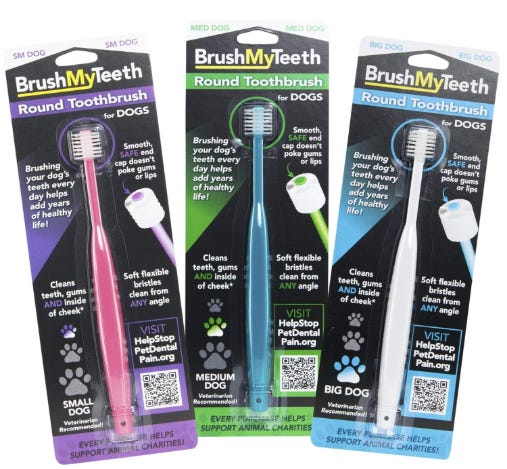
Changing the meal just to change the meal may not work successfully. If you’re worried about your dog putting on weight, changing the food and making him sicker is not the right move.
It may be a matter of the owner getting more active with the dog, allowing the dog to play in larger spaces or invest in active toys, or simply not leaving the dog in the basement or house all day long.
The breed’s activity needs will matter as much, if not more, than the diet. But unlike the more obvious observations that can be made from seeing a dog tire out while walking or running, food transitions may take a little longer.
It can be as unpleasant as bad gas, burping or panting. Or, a bit quieter, such as feeling lethargic or opting out of certain foods. Pay very close attention before changing your dog’s diet from what he is used to eating. For every dog that loves a certain type of meal, there will be dogs who hate it.
For every dog who transitions without a problem, there may be one who has a tough go at it. Keep a food record of how the dog’s behavior matches up with the food transition. Hopefully, your dog gets the healthier diet he needs without any long-term health scares. Keep your veterinarian aware of any alarming changes immediately.
How do I handle picky eaters?
There’s only so much you can do to make your dog eat the new legume-free dog food meal. You can try sneaking it into snacks or mixing it in with other food. But if you get to the point where your dog refuses to eat altogether, especially for more than a day, you may have to bow out and try another food option.
Just because one legume-free option isn’t his most desired choice doesn’t mean another one won’t. For a multi-dog home, it’s not uncommon for one dog to like a meal while the other one doesn’t. If one likes a meal that the other one doesn’t, pay special attention to what ingredients are in one versus a second option.
Knowing what the pickier dog eats around could solve the mystery pretty quickly. Are peas the problem? Is it sweet potatoes? Then just buy a similar meal without this ingredient, or feed it to the less-picky dog.
If the dog will not eat the entire meal altogether but will eat other options, don’t put your dog at risk of eating that or nothing. Some refused meals aren’t just a matter of not tasting as good as dog “junk” food or treats.
They could be making the dog sick. If you find that your dog eats a meal (because he feels he has no other choice) but reacts poorly to it, remove it immediately.
Ask a veterinarian if his reaction is normal. If it is, maybe try a few more times but watch him closely. If not, move on to another option or return to a previous diet.
Incorporating food and vegetables into a dog’s diet
As mentioned in the 13 options above, there are plenty of fruits and vegetables (either dried or fresh) in the meal. But can dog owners just feed the dog the same fruits and veggies without the dry food? Yes, but there should be a few warnings before doing so.
For example, the fruit that get a thumbs up from AKC include apples, bananas, blueberries, cantaloupe, cranberries, cucumbers, mango, oranges, peaches, pears, pineapples, raspberries, strawberries and watermelon.
Recommended Read: “Just because your dog can eat fruits doesn't mean she should ~ Wait at least 48 hours for the dog fruit test results”
The vegetables that get a thumbs up are broccoli, brussels sprouts, carrots, celery, green beans, peas and spinach. There are quite a few meals above that include cranberries, raspberries, broccoli, carrots, spinach and peas. There are also many that do not include any of the above.
Should legume-free dog food meals skip out on them? It depends. There are pros and cons for a few. Seeds and the core should be removed before giving a dog apples, and treat oranges the same by removing the peels and seeds.
Bananas, mango, strawberries and cantaloupe have a high sugar count, so overweight and/or diabetic dogs should get these treats in moderate doses. If your dog can handle the tart, cranberries should be good. But as with all sour snacks, it can lead to an upset stomach if too many are given out.
Recommended Read: “Making a vegetable grocery list for you and your dog ~ Strategizing the best use of outer aisle shopping in grocery stores and gardens”
Peaches are absolutely great summer treats, but skip the pit and leave the canned versions on the shelf. Pears follow the same rules as peaches. Raspberries are great for digestion. However, they also include xylitol (a sugar substitute) and can lead to liver problems if a dog is given too many and too often.
As far as vegetables, dogs tend to have the same smelly problems that people do when it comes to too many of them: gas. Broccoli and brussels sprouts are high on the culprit list. Carrots, celery and (unsalted) green beans are better options. Peas are rich in protein and fiber, but as with green beans, the canned versions can be too salty.
Generally speaking, both dogs and human beings may want to consider fresh produce as opposed to grabbing the can opener for all veggies. The same goes for spinach.
So if your dog can eat all of the above, would it make more sense to take a sweeping arm around the produce aisle? Yes and no. This can get really expensive, really fast. And dry dog food options often have the meat they’re looking for, along with the fruits and vegetables.
If you really want to know which veggies and which fruits your dog likes, try these a little at a time to figure out which get high marks and which upturned noses. This may make the dog food shopping a little bit easier and way less of a hassle for online returns.
Bottom Line
Why would legumes, lentils, peas and/or potatoes be bad for dogs when they’re so often good for human beings? The same reason why human beings can use toothpaste, but it’s toxic for dogs.
No matter how much some may dress their dogs up like little toddlers, their diet should always take into consideration who they are — fur dogs, not fur babies.
As much as we’d like to believe that we can feed dogs all kinds of organic meals and raw products, it simply comes down to each dog’s reaction (including in that breed).
You’ll notice that of the 13 dog food brands included in the DCM report, these are pretty popular dog food brands sold in stores and online.
While dog health professionals emphasize that “there is no proof that these ingredients are the cause of DCM in a broader range of dogs,” dog owners should always be aware of the potential risks in any new product that they give their dog. This includes everything from dog food to dog treats to medication to toys.
Additionally, there are some fruits and vegetables that dogs shouldn’t be eating anyway. Some of the favorite ones in your refrigerator that are a bad idea for dogs include asparagus, avocados, cherries, grapes, mushrooms, onions and tomatoes.
Interestingly, although health cases with peas were involved in the heart risk stories, the American Kennel Club still finds perks of eating garden or English peas, green peas, snow peas and sugar snap peas.
Canned peas with sodium get a bad reputation though. And as mentioned above, sometimes the produce aisle is the way to go instead of dried food options.
Whether you want to take the suggestion above and test the foods out one at a time or try small versions of the dog food is totally up to you. Hopefully one (or more) of the 15 options above are a happy medium for your dog’s specific health needs.
Want to read more pet supply listicles? Click here!
Shamontiel is a dog lover to her core: 604 completed walks with 99 dogs, eight dog-housesittings and six dog boardings at the time of this publication.
Did you enjoy this post? You’re also welcome to check out my Substack columns “Black Girl In a Doggone World,” “BlackTechLogy,” “Homegrown Tales,” “I Do See Color,” “One Black Woman’s Vote” and “Window Shopping” too. Subscribe to this newsletter for the weekly posts every Wednesday. Thanks for reading!

